
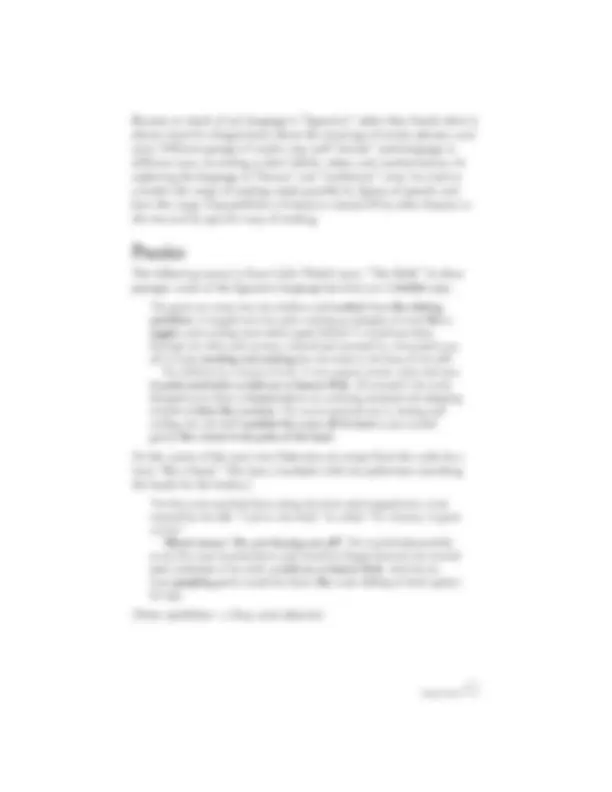
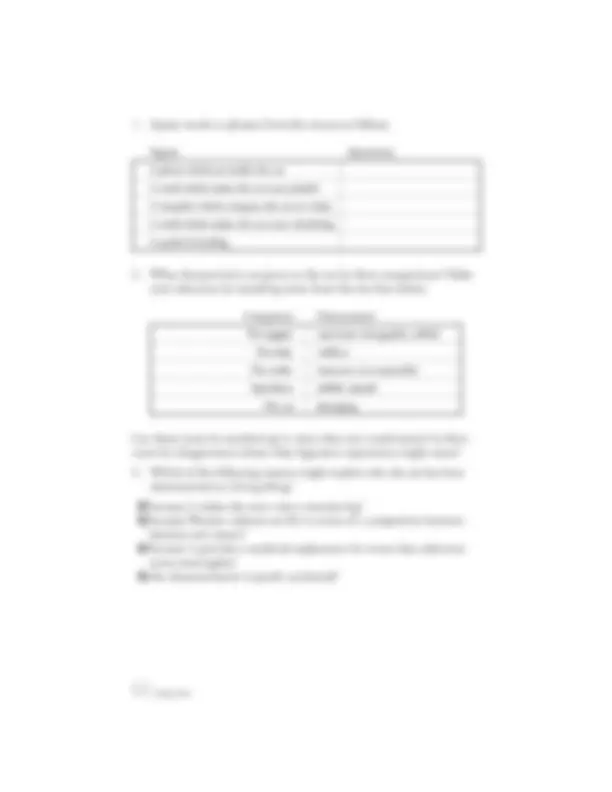
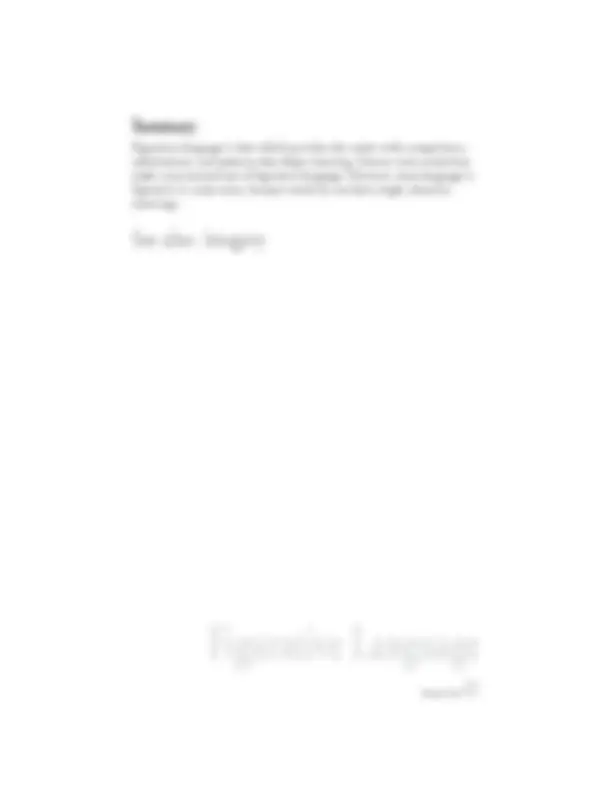
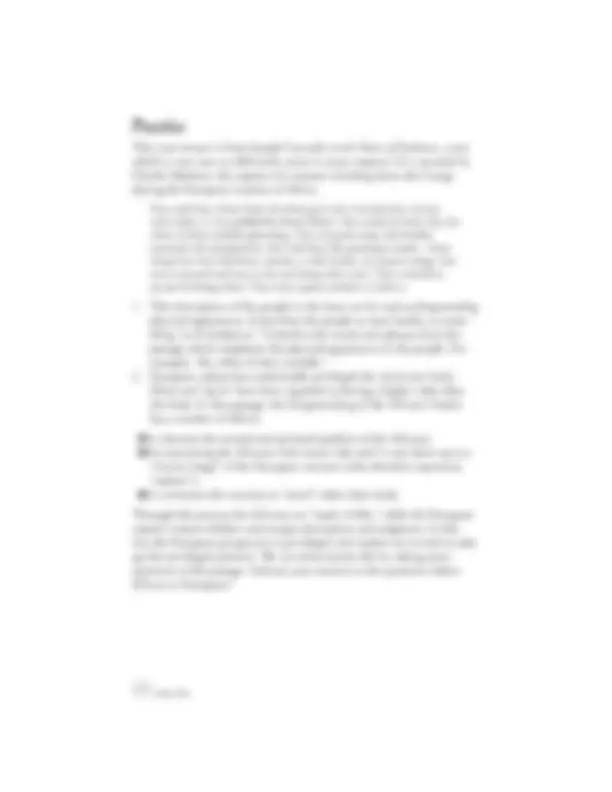
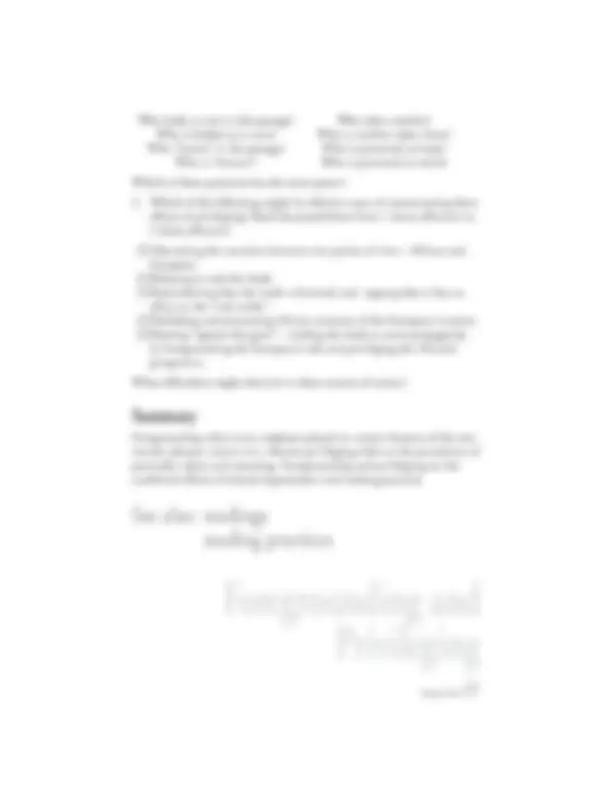
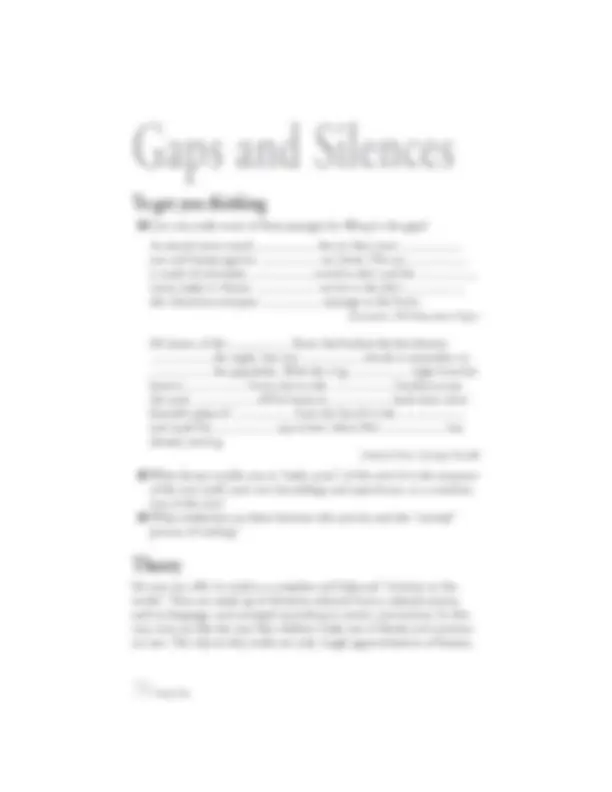
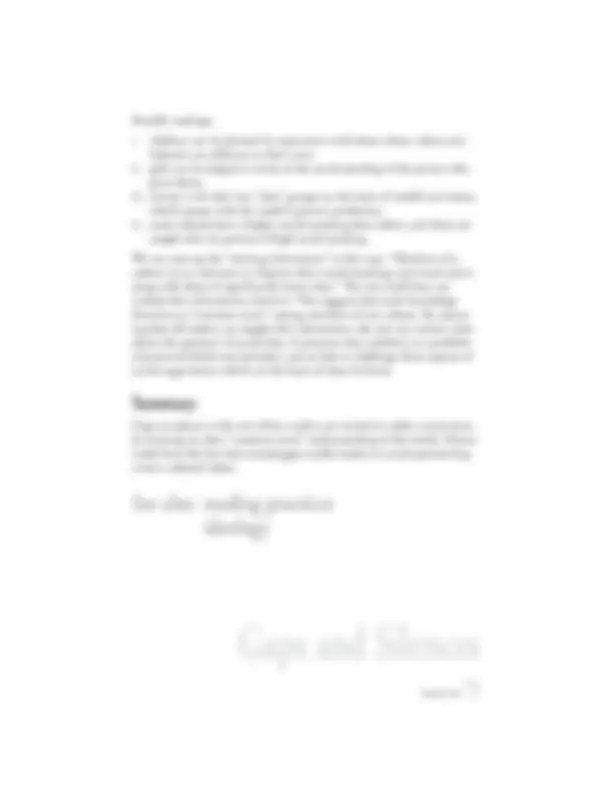
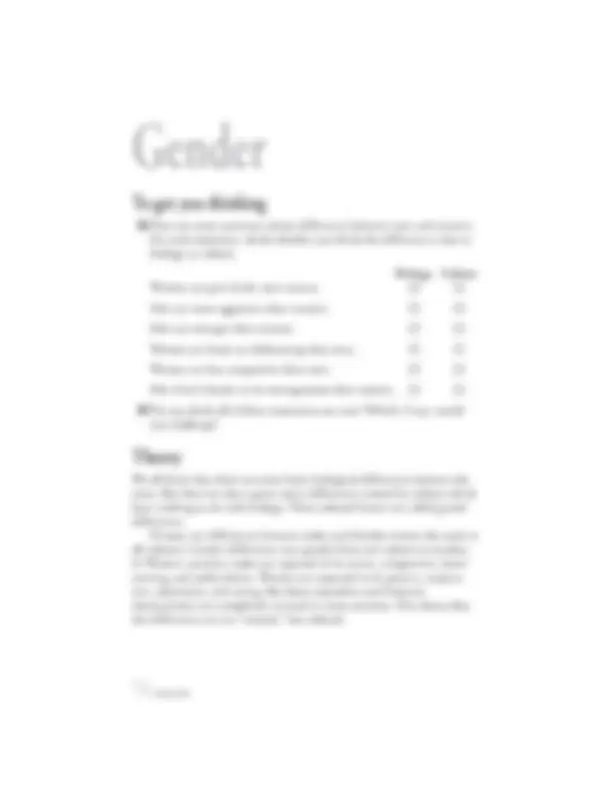
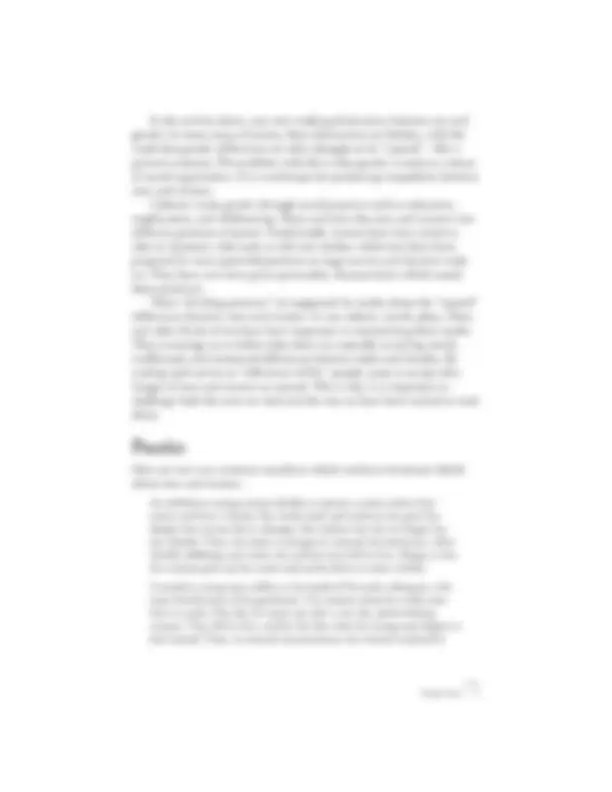
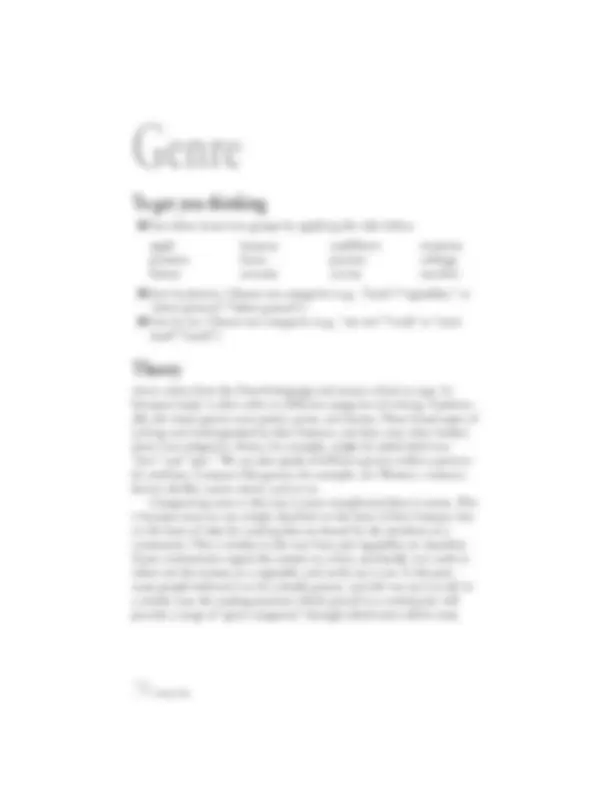
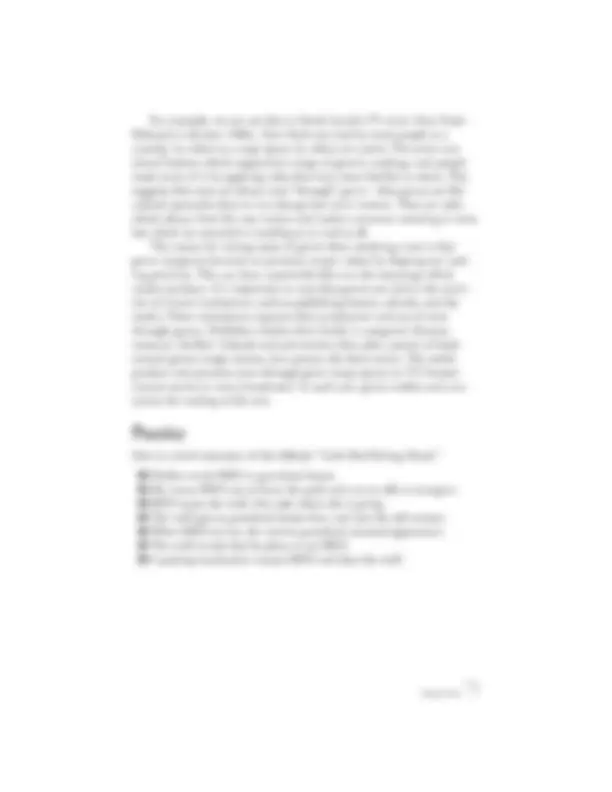
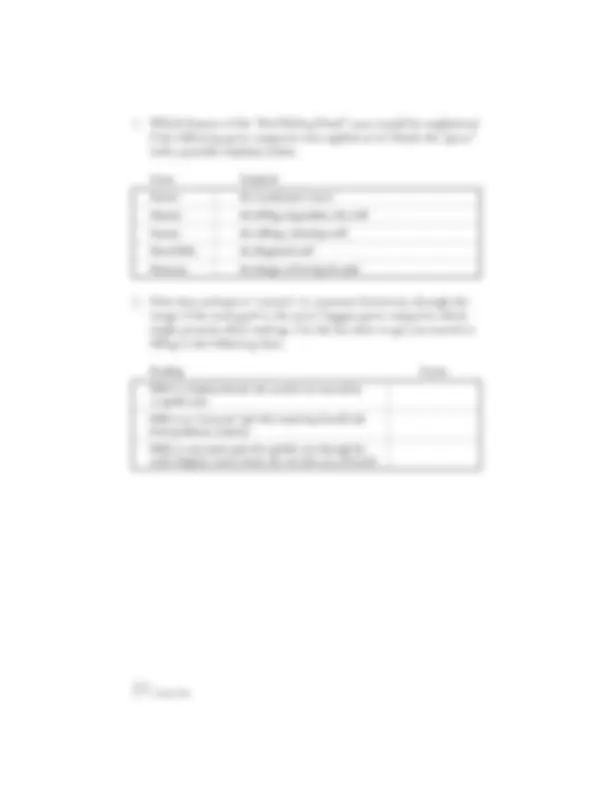
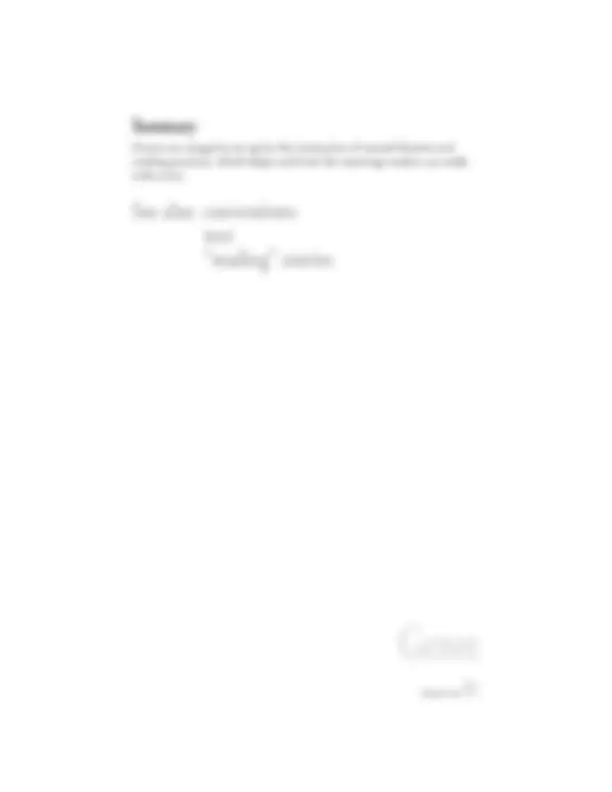
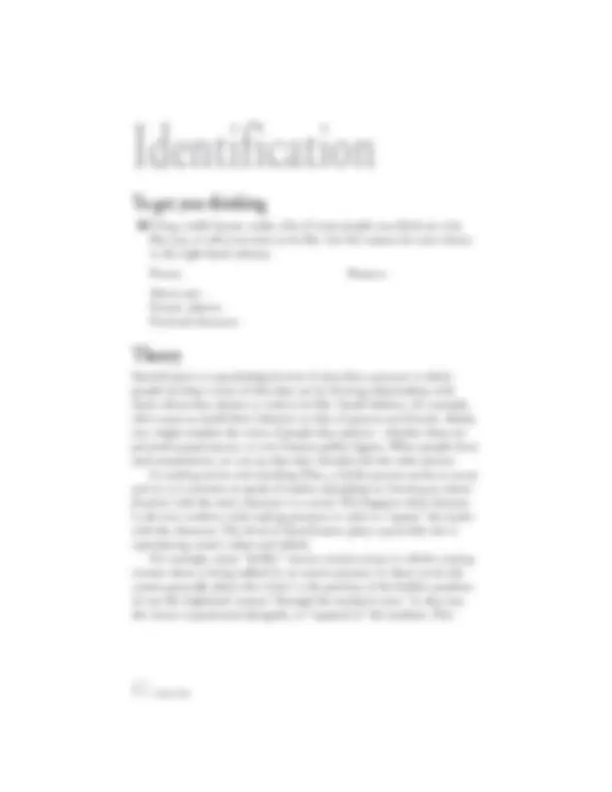
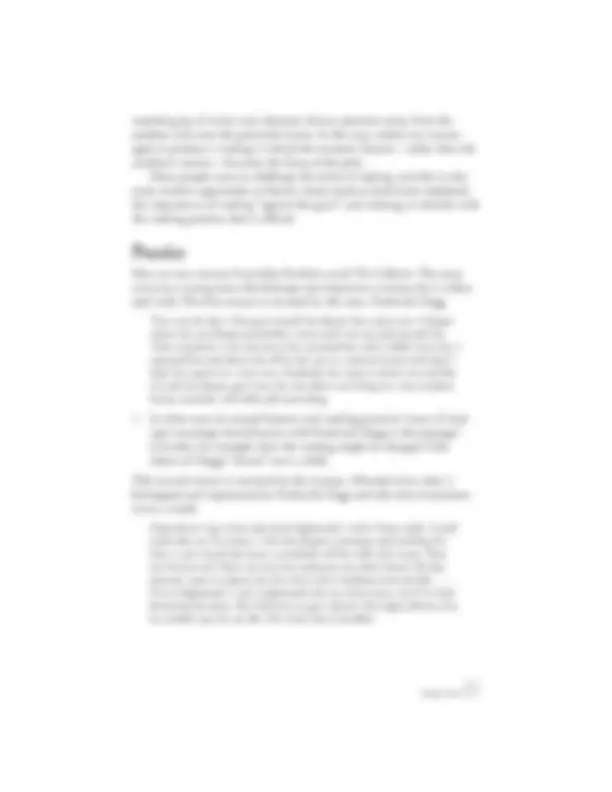
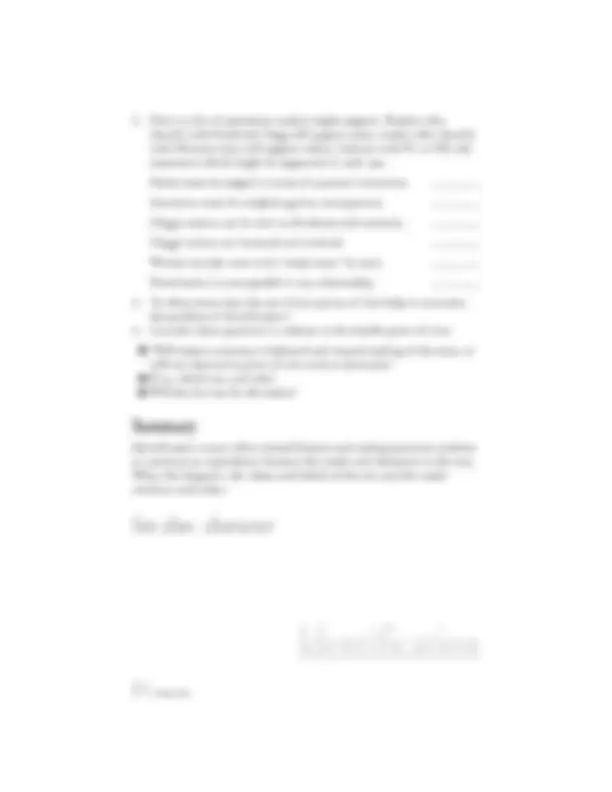
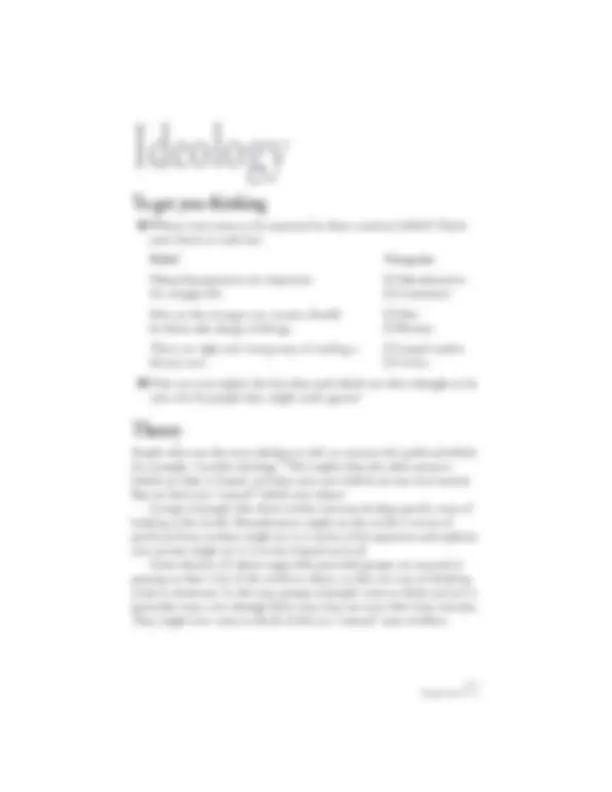
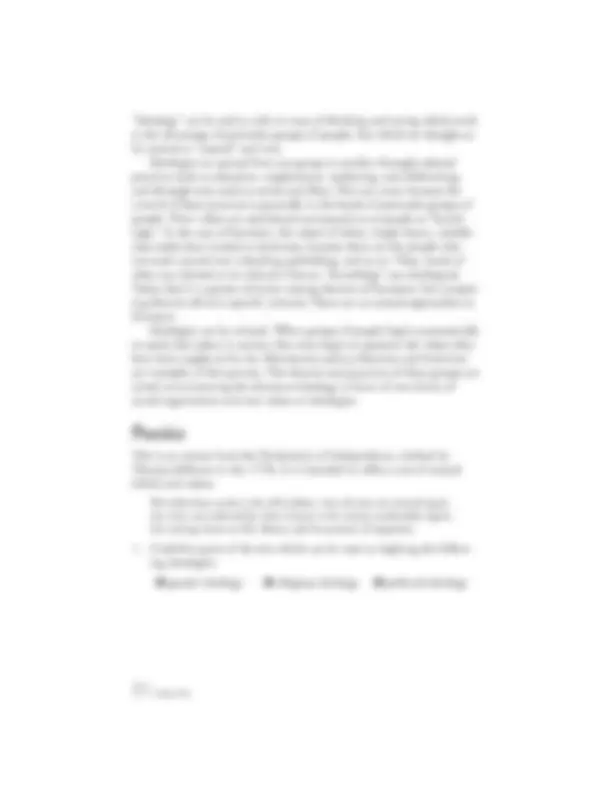
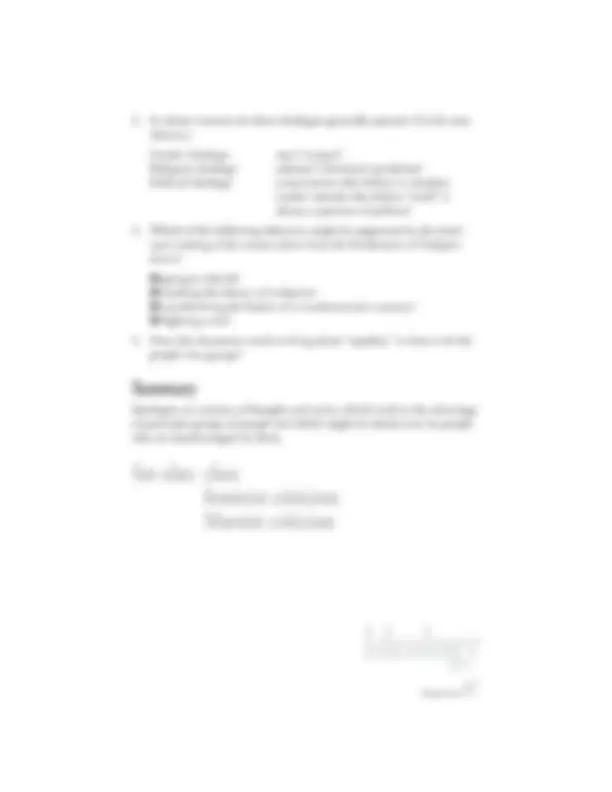


Study with the several resources on Docsity

Earn points by helping other students or get them with a premium plan


Prepare for your exams
Study with the several resources on Docsity

Earn points to download
Earn points by helping other students or get them with a premium plan
Community
Ask the community for help and clear up your study doubts
Discover the best universities in your country according to Docsity users
Free resources
Download our free guides on studying techniques, anxiety management strategies, and thesis advice from Docsity tutors
Because so much of our language is “figurative” rather than literal, there is always room for disagreement about the meanings of words, phrases, and texts.
Typology: Study notes
Uploaded on 09/27/2022
1 / 27

This page cannot be seen from the preview
Don't miss anything!




















Can you say what two things are being compared in each of the following phrases? Phrase Elements My love is like a red, red rose. Lover & flower The moon was a ghostly galleon tossed upon cloudy seas. & The minister waddled up to the speaker’s platform, ruffled his plumage important- ly, and addressed the crowd. & Shared beliefs are the foundation of any society. & The old man in the corner was well known for spinning yarns. & Are these “special” uses of language? Would you find any of them in everyday conversation?
The term “figurative” language has traditionally referred to language which differs from everyday, “nonliterary” usage. Figures were seen as stylistic ornaments with which writers dressed up their language to make it more entertaining, and to clarify the meanings they wanted to convey. According to this view, literary devices such as metaphor, simile, rhythm, and so on, embellished “ordinary” language, and so forced readers to work harder at making meaning in a text. Nowadays we recognize that all language is in some sense “figurative”: there are very few ways of talking and writing about the world that do not make use of comparisons, sym- bols, and so on.
The following are some important figures.
Simile
The comparison of two elements, where each maintains its own identity. For example: “My love is like a red, red rose.” Here a person is compared to a flower in a way that suggests they have certain features in common, such as beauty, fragility, and so on.
Metaphor
The merging of two elements or ideas, where one is used to modify the meaning of the other. For example: “The moon was a ghostly galleon tossed upon cloudy seas.” Here the image of the moon in a cloudy night sky is merged with that of a sailing ship on stormy seas, so that some characteristics of the latter are transferred to the former.
Metonym
The use of a part to represent a whole, or the use of one item to stand for another with which it has become associated. For example, in the news headline “Palace Shocked by Secret Photos,” the palace stands for the royal family and their aides.
Personification
The description of a nonhuman force or object in terms of a person or living thing. For example, “The gnarled branches clawed at the clouds.” Here, the tree branches are given the characteristics of grasping hands.
Symbol
The substitution of one element for another as a matter of convention rather than similarity. For example, in the biblical story of Adam and Eve, the serpent is used as a symbol of temptation. In the ceremonies of the modern Olympics, white doves symbolize peace and freedom. Language itself is also symbolic, since words and meanings are associated purely by convention.
Figures Quotations A phrase which personifies the sea A simile which makes the sea seem playful A metaphor which compares the sea to a baby A simile which makes the sea seem calculating A symbol of trading
Comparison Characteristics The juggler capricious (changeable, selfish) The baby ruthless The trader innocent, not responsible Quicklime skillful, playful The cat damaging
Can these items be matched up in more than one combination? Is there room for disagreement about what figurative expressions might mean?
Figurative language is that which provides the reader with comparisons, substitutions, and patterns that shape meaning. Literary texts sometimes make concentrated use of figurative language. However, most language is figurative in some sense, because words do not have single, objective meanings.
See also: imagery
Figurative Language
For example:
In this extract from Charles Dickens’s novel, Hard Times , repetition and selection of detail have been used to foreground the “mechanical” style of the teacher, Mr. Thomas Gradgrind. (The scene is set in a nineteenth- century schoolroom.)
“Now, what I want is, Facts. Teach these boys and girls nothing but Facts. Facts alone are wanted in life. Plant nothing else, and root out everything else. You can only form the minds of reasoning animals upon Facts: nothing else will ever be of service to them.. .” The scene was a plain bare monotonous vault of a schoolroom, and the speaker’s forefinger emphasised his observations by underscoring every sentence with a line on the schoolmaster’s sleeve... “Girl number twenty,” said Mr. Gradgrind, squarely pointing with his square forefinger, “I don’t know that girl. Who is that girl?” “Sissy Jupe sir,” explained number twenty, blushing, standing up, and curtseying. “Sissy is not a name,” said Mr. Gradgrind. “Don’t call yourself Sissy. Call yourself Cecilia.”
We could say that this extract foregrounds the rigid discipline of Thomas Gradgrind’s approach to teaching through repetition (“Facts”) and through details such as the numbering of the students. Dickens’s novel is often read as an attack on “cold and unfeeling” forms of education. Read in this way, the text seems to place a higher value on emotions and relationships than on “cold facts.” That is, in foregrounding the “mechanical,” it privileges the personal/humane. How- ever, different readings of the text might place the emphasis elsewhere. To a culture which values factual knowledge over feelings, this text might seem to offer a positive image of rigorous instruction. In such a reading, the same textual details might be foregrounded , but an opposing set of values would be privileged. By exploring a text in terms of forgrounding and privileging, we can begin to see how certain attitudes and values are promoted by particular readings.
This next extract is from Joseph Conrad’s novel Heart of Darkness , a text which is now seen as offensively racist in many respects. It is narrated by Charlie Marlowe, the captain of a steamer traveling down the Congo during the European invasion of Africa.
Now and then a boat from the shore gave one a momentary contact with reality. It was paddled by black fellows. You could see from afar the white of their eyeballs glistening. They shouted, sang; their bodies steamed with perspiration; they had faces like grotesque masks—these chaps; but they had bone, muscle, a wild vitality, an intense energy that was as natural and true as the surf along their coast. They wanted no excuse for being there. They were a great comfort to look at.
Through this process the Africans are “made visible,” while the European captain remains hidden and escapes description and judgment. In this way the European perspective is privileged, and readers are invited to take up this privileged position. We can demonstrate this by asking some questions of the passage. Indicate your answers to the questions below: African or European?
Can you make sense of these passages by filling in the gaps? As sound waves travel the air they enter ears and bump against ear drum. The ear is made of extremely , sensitive skin and the waves make it vibrate. nerves in the skin the vibrations and pass message to the brain. ( Sensations , WA Education Dept.)
Mr Jones, of the Farm, had locked the hen-houses the night, but was drunk to remember to the pop-holes. With the ring light from his lantern from side to side, lurched across the yard, off his boots at back door, drew himself a glass of from the barrel in the , and made his up to bed, where Mrs was already snoring. ( Animal Farm , George Orwell) What factors enable you to “make sense” of the text? Is it the structure of the text itself, your own knowledge and experiences, or a combina- tion of the two? What similarities are there between this activity and the “normal” process of reading?
No text can offer its readers a complete and balanced “window on the world.” Texts are made up of elements selected from a cultural system, such as language, and arranged according to certain conventions. In this way, texts are like the toys that children make out of blocks and construc- tor sets. The objects they make are only rough approximations of houses,
cars, and airplanes. What makes these things meaningful is the informa- tion supplied by the child: memories, imagination, playfulness. Like these toy houses, texts offer only a particular impression or version of reality, shaped by the basic elements from which they are made. For a text to mean anything at all, readers must apply a set of procedures to “decode” the signs and fill in background information. Readers make meaning with texts by supplying readings that are already available in the culture. A line such as: “he behaved like a prince,” for example, invites readers to make use of a range of memories and beliefs about princes, romantic love, men and women, and so on. The “spaces” of a text can be described in many ways. Modern ap- proaches often speak of them as “gaps and silences.” Gaps are places where the text does not bother to stitch things together but instead relies on “common sense” assumptions from the reader. For example, here is an extract from a news report.
Miss Smith is the second girl to be reported missing this week. She was last seen hitchhiking along a city street late on Monday afternoon. Police have issued a warning to young girls not to go out alone at night.
These sentences do not say outright that there was a connection between Miss Smith’s hitchhiking and her disappearance; it is assumed that readers will make the connection. But the link is not obvious. It relies on very specific cultural knowledge about “the way the world works.” In order to construct the dominant reading of this passage, readers must assume:
that the girl was kidnapped while walking; that she was kidnapped by a male; that this would be less likely to happen if she was accompanied; that she was taking a risk by hitchhiking; and so on.
If we resist the invitation to fill this gap with the conventional assump- tions, the text’s incompleteness becomes very obvious. It then becomes clear that the message requires readers to reproduce “unconsciously” a very strange set of assumptions about what “natural” behavior is! Silences result from the fact that textual gaps enable readers to avoid questioning certain cultural values. In the above example, the text remains silent about the behavior and motivations of men , even though it could have been written by a woman or a man. This has the double effect of
Possible readings:
i. children can be harmed by association with those whose values and behavior are different to their own; ii. gifts can be judged in terms of the social standing of the person who gives them; iii. society is divided into “class” groups on the basis of wealth and status, which equate with the (male?) parent’s profession; iv. some schools have a higher social standing than others, and these are sought after by parents of high social standing.
We can sum up the “missing information” in this way: “Members of a culture try to maintain or improve their social standing, and avoid associ- ating with those of significantly lower class.” The text itself does not include this information, however. This suggests that such knowledge functions as “common sense” among members of our culture. By assum- ing that all readers can supply this information, the text can remain silent about the question of social class. It presents class snobbery as a problem of personal beliefs and attitudes, and so fails to challenge those aspects of social organization which are the basis of class divisions.
Gaps are places in the text where readers are invited to make connections by drawing on their “common sense” understanding of the world. Silences result from the fact that textual gaps enable readers to avoid questioning certain cultural values.
See also: reading practices
ideology
Gaps and Silences
Here are some assertions about differences between men and women. For each statement, check whether you think the difference is due to biology or culture. Biology Culture Women can give birth; men cannot. Men are more aggressive than women. Men are stronger than women. Women are better at childrearing than men. Women are less competitive than men. Men find it harder to be monogamous than women. Do you think all of these statements are true? Which, if any, would you challenge?
We all know that there are some basic biological differences between the sexes. But there are also a great many differences created by culture which have nothing to do with biology. These cultural factors are called gender differences. Primary sex differences between males and females remain the same in all cultures. Gender differences vary greatly from one culture to another. In Western societies, males are expected to be active, competitive, domi- neering, and authoritative. Women are expected to be passive, coopera- tive, submissive, and caring. But these masculine and feminine characteristics are completely reversed in some societies. This shows that the differences are not “natural,” but cultural.
danger. The young man risks his life to save her, and in the process proves himself braver than his colleagues. His life is changed. People treat him with new respect, he gains a promotion, and marries his sweetheart, who takes off her glasses, lets down her hair, and is revealed to be very beautiful.
Masculine Feminine career-oriented family-oriented
Gender refers to the social categories of masculinity and femininity. These categories are related to sex differences in complex ways, but they are produced by culture, not biology.
See also: feminist criticism
representation
Gender
For example, we can see this in David Lynch’s TV series Twin Peaks. Released in the late 1980s, Twin Peaks was read by some people as a comedy, by others as a soap opera, by others as a satire. The series con- tained features which supported a range of generic readings, and people made sense of it by applying rules that were most familiar to them. This suggests that texts are always read “through” genre—that genres are like colored spectacles that we can change but never remove. They are rules which always limit the way writers and readers construct meaning in texts, but which are essential in enabling us to read at all. The reason for raising issues of genre when studying a text is that genre categories function to promote certain values by shaping our read- ing practices. This can have a powerful effect on the meanings which readers produce. It is important to note that genres are tied to the activi- ties of certain institutions, such as publishing houses, schools, and the media. These institutions organize their production and use of texts through genres. Publishers market their books in categories (fantasy, romance, thriller). Schools and universities often plan courses of study around genres (tragic drama, lyric poetry, the short story). The media produce and promote texts through genre (soap operas on TV, human interest stories in news broadcasts). In each case, genre enables and con- strains the reading of the text.
Here is a brief summary of the folktale “Little Red Riding Hood.”
Mother sends RRH to grandma’s house. She warns RRH not to leave the path and not to talk to strangers. RRH meets the wolf, who asks where she is going. The wolf gets to grandma’s house first, and eats the old woman. When RRH arrives, she notices grandma’s unusual appearance. The wolf reveals that he plans to eat RRH. A passing woodcutter rescues RRH and slays the wolf.
Genre Emphasis Horror the woodcutter’s rescue Mystery the killing of grandma, the wolf Fantasy the talking, scheming wolf Moral fable the disguised wolf Romance the danger of leaving the path
Reading Genres RRH is a helpless female who needs to be rescued by a capable man. RRH is an “innocent” girl who must keep herself safe from predatory creatures. RRH is a perceptive girl who quickly sees through the wolf ’s disguise, and so shows she can take care of herself.